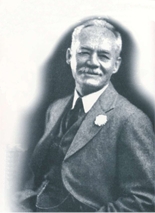Wilfred
Grenfell
Missionary
Doctor of Labrador 1865-1940
Sir Wilfred Thomason
Grenfell is one of Canadaís most romantic heroes of the north. He was of
an era when Victorian missionaries flung themselves into the far corners
of the globe to bring civilization to the real or imagined uncivilized.
Grenfell, motivated by both his religious and medical influences, brought
to the coastal communities of Newfoundland, Labrador, and Quebec, a new
degree of health care.
Born February 28,
1865 at Parkgate, Cheshire, England, Wilfred Grenfell received his medical
education at Oxford University and London Hospital School. Converted to
active Christianity in 1885 by Dwight L. Moody, an American evangelist,
Grenfell practised his social gospel when he was fishermanís doctor in
the North Sea in 1886. The National Mission to Deep Sea Fishermen made
Grenfell a superintendent in 1889, and after an urgent call to visit Newfoundland
in 1892, he returned to England where he pleaded passionately for funds
to aid thousands of seasonal cod fishermen, over 3,000 permanent settlers,
and the native people living on the coast who had been serviced only by
one government doctor on an annual visit from the Newfoundland colony.
 |
Grenfell
chose the rugged shoreland of Newfoundland and Labrador to serve humanity.
Here, the medical missionary established schools, cooperatives, hospitals,
nursing stations, and an orphanage to accommodate the immense needs of
isolated communities located in bleak surroundings and harsh climate. [From
Forty Years from Labrador, 1932] |
The first mission
flag was planted at Battle Harbour on the eastern tip of Labrador at the
entrance to the Strait of Belle Isle in 1893. Hospitals, orphanages, schools,
nursing stations, industrial centres, agricultural stations, and cooperative
stores soon followed at other locations in Quebec, Labrador, and at his
eventual headquarters at St. Anthony, Newfoundland. Facilities included
a marine slip at St. Anthony to repair mission boats and fishing vessels,
and a hospital ship used for annual cruises on the coast. There was also
support of local handicraft business. The cooperatives helped break an
economic dependence on unscrupulous merchants; the social clubs he promoted
contributed to a sense of community and self-help.
As a widely read
author and skilled lecturer, Grenfell brought attention and money to his
mission. In 1909 he married the Chicago heiress, Ann MacClanahan, and a
great deal of his support came from the United States. The International
Grenfell Association was incorporated in 1912 as an umbrella of organizations
in St. Johnís, Newfoundland; London, England; New York and Boston in the
United States and the Grenfell Labrador Medical Mission of Canada. Also
in 1912 Grenfell opened the King George V Institute in St. Johnís. Through
hard work, courage, devotion, and a sense of mission for which the late
Victorians were justly famous, Grenfell brought international attention
to the plight of the cod fisherman.
 |
| First
hospital established and built by Wilfred Grenfell was located at Battle
Harbour, at the southern tip of Labrador, in 1893. Fire destroyed the mission
in 1931. Stereograph depicts Dr. Grenfell leading a prayer meeting at Battle
Harbour, circa 1895. [Photo, courtesy Charles J. Humber Collection] |
Medical missionary,
master mariner, and author, Wilfred Grenfell retired from active work in
Labrador in 1927 and was living in Vermont still actively promoting his
mission when he died on October 9, 1940. When Newfoundland joined the Canadian
confederation in 1949, various segments of Grenfellís institutions were
absorbed by government bodies, especially with the introduction of the
Canada Health Act.
Peeling away the
social mission behind the Grenfell effort, one finds a concerned medical
man seeking practical means for providing a minimum level of health care
on a rugged, isolated coastline. He was part of the advance force of authoritarian
regenerators as represented by missions, police detachments, medical stations,
and government agencies focusing on recognizing and assuming responsibility
for the remote corners of Canadaís North. Grenfell will be remembered as
a pioneer in medical outreach, and for his delivery of vital services to
remote regions of the far North. His personal papers are located at Yale
University.
Larry Turner